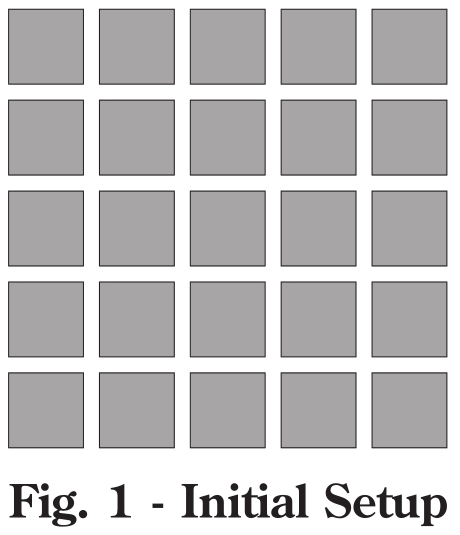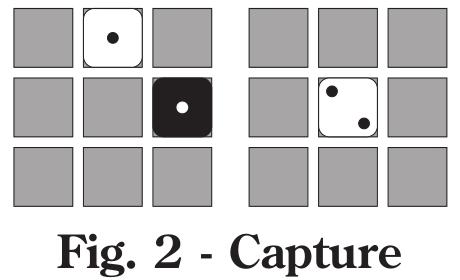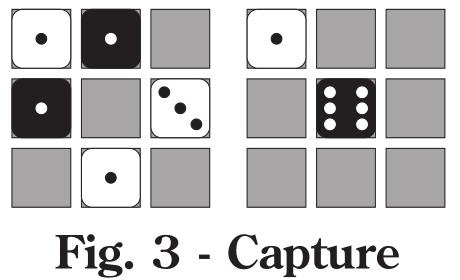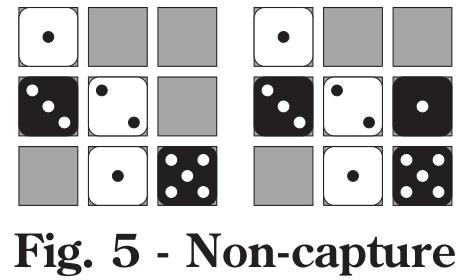This is a documentation for Board Game Arena: play board games online !
Gamehelpcephalopod: diferenças entre revisões
Sem resumo de edição |
Sem resumo de edição |
||
| Linha 1: | Linha 1: | ||
<h4>INTRODUCTION </h4> <p>Cephalopod is a two player game which employs a 5x5 board, 24 dice of one color, and 24 dice of another color. The board starts out vacant as shown in Figure 1. Mark Steere invented Cephalopod on February 25, 2006. </p> | <h4>INTRODUCTION </h4> <p>Cephalopod is a two player game which employs a 5x5 board, 24 dice of one color, and 24 dice of another color. The board starts out vacant as shown in Figure 1. Mark Steere invented Cephalopod on February 25, 2006. </p> | ||
[[Image:Cephalopod_fig1.jpeg | [[Image:Cephalopod_fig1.jpeg|upright]] | ||
<h4>BASIC PLACEMENT</h4> | <h4>BASIC PLACEMENT</h4> | ||
<p>Players take turns adding dice of their own color to the board, one die per turn. A newly placed die must show a one, unless it’s a capturing placement, in which case it must show a two or higher. Each player will always have a placement available and must make one. Players cannot pass on their turn.</p> | <p>Players take turns adding dice of their own color to the board, one die per turn. A newly placed die must show a one, unless it’s a capturing placement, in which case it must show a two or higher. Each player will always have a placement available and must make one. Players cannot pass on their turn.</p> | ||
Revisão das 06h36min de 22 de maio de 2022
INTRODUCTION
Cephalopod is a two player game which employs a 5x5 board, 24 dice of one color, and 24 dice of another color. The board starts out vacant as shown in Figure 1. Mark Steere invented Cephalopod on February 25, 2006.
BASIC PLACEMENT
Players take turns adding dice of their own color to the board, one die per turn. A newly placed die must show a one, unless it’s a capturing placement, in which case it must show a two or higher. Each player will always have a placement available and must make one. Players cannot pass on their turn.
OBJECT OF THE GAME
Once the board has been completely filled, the player whose dice occupy the majority of the squares wins. Draws and ties cannot occur in Cephalopod.
CAPTURING PLACEMENT
If a die is placed horizontally or vertically adjacent (hereafter “adjacent”) to two dice, and the sum of the pip counts (number of spots on the top surface of a die) on those two adjacent dice is six or less, then the currently played die must show the pip sum of its two adjacent dice, and the player must remove those two adjacent dice from the board immediately, while it is still his turn. In Figure 2 White places a two in the center of the board, and thereby captures the two ones. Captured dice are returned to their owners.
Similarly, if a die is placed adjacent to three or four dice, and if two, three, or four of its adjacent dice have a pip sum of six or less, then two, three, or four of those adjacent dice (whose pip sum is six or less) must be removed, and the played die must show the pip sum of the removed dice. In Figure 3, Black plays a six in the center of the board and thereby captures all four adjacent dice whose pip sum is six (1+1+1+3=6).
In Figure 4 Black decides to capture the two white ones. So he places a two in the top center square adjacent to the two ones, and removes them.
Captures are mandatory only when placing a die onto a square from which captures are possible.
NON-CAPTURING PLACEMENT
A player can make a non-capturing placement simply by adding a die to a square from which no captures are possible. A non-capturing placement must show a single pip. In Figure 5 Black places a die in the right center square. The only adjacent dice are a five and a two. The five and two cannot be captured since their sum is greater than six (5+2=7). Black’s placement is therefore non-capturing and must show a one.
Players always begin their turn by adding a die. Only dice which are adjacent to the currently added die, and whose pip sum equals the pip count of the currently added die may be removed during the current turn.
AUTHOR’S NOTE
Feel free to publish this rule sheet, and to program the game of Cephalopod for online or off l ine play. No licensing fee or royalties are expected. However please don’t change the name or the rules, and please attribute the game to me, Mark Steere. My other games can be found at marksteeregames.com.
Copyright (c) February 2006 by Mark Steere




